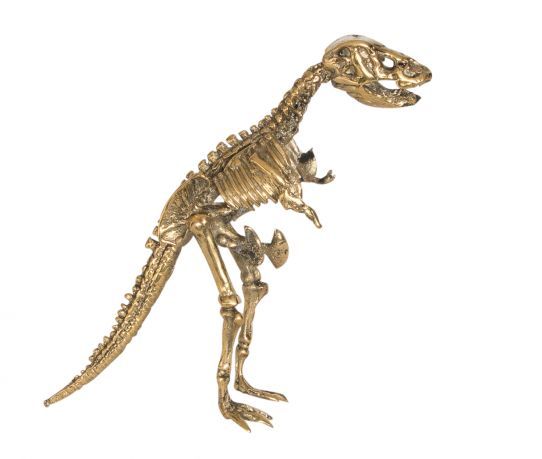We use cookies to make your experience better.
Tyrannosaurus Rex in 22 carat gold plated bronze very nice hand molded object that is very decorativ
There are several methods and procedures have been possible to cast bronze. Below attempts to give a summary of the basic steps. A model is made, typically of wax. but as a rubbermal of is made, it can also be of clay, gypsum, plastic or even wood or stone. The wax used for this is generally casting wax, modeling wax or paraffin. For small wax models, the watering can immediately proceed to the next step. For larger models or scale models of clay or plaster must first be made a hollow wax model. To this end, the watering can is usually a rubbermal with a plaster support cap, which ensures that the rubber mold retains its shape. In this rubbermal different materials can be molded at relatively low temperature, such as casting wax or gypsum. In this case, a cast of hard was needed, which is already on the thickness of the final bronze. Above a certain thickness it is indeed difficult to pour massive bronze, by uneven shrinkage of thicker and thinner parts. The watering can pouring in the liquid wax rubbermal, until a layer thickness was at the right in the mold is solidified. The rest is drained, thus creating a hollow wax casting. The (hollow) casting is provided with projections which serve subsequently to wash as casting channels for the supply of the bronze and venting channels for the discharge of the air in the mold. The wax casting, including channels, the inside and outside covered with a refractory material. This can be a mixture of gypsum and chamotte or other shrink-proof and fire-proof material. Stainless steel core support will ensure that the distance between the core and the outside remains the same. The completed mold is heated for a long in an oven in order to melt out the wax and to remove all moisture from the mold, and if this is made of plaster, also all chemically bound water. There has now arisen a dry mold having a cavity in the shape of the model with casting channels. This liquid bronze is poured. After cooling, the channels are cut away and the casting is finished: blackberries and projections are ground away and unwanted holes and cavities are close hammered or welded. To protect against oxidation and for the embellishment is at bronze castings, particularly in the sculpture, often arranged a patina layer with chemicals, the so-called patina.
The dinosaurs and dinosaurs (the first name is the correct translation of Dinosauria, the scientific name of the group) are a group of animals belonging to the Archosauria, which dates back to the Mesozoic. The Dinosauria originated about 230 million years ago in the Triassic, where the division within the wider group of dinosauriformes. The first dinosaur was a small bipedal carnivore. That was the direct ancestor of the two main groups in which all other dinosaurs can be divided: the Saurischia and Ornithischia. In these two groups quickly developed also herbivorous species. The dinosaurs were dominant at the end of the Triassic, when the country became extinct most other large animals. During the subsequent Jurassic and Cretaceous dinosaurs were 140 million years, the dominant land animals, probably the greatest that ever lived. Thousands of species, carnivores and herbivores, developed in various forms, including by moving apart the continents. The marine reptiles of that time and the pterosaurs, flying reptiles, however, were not dinosaurs. At the end of the Cretaceous, 66 million years ago, most dinosaurs became extinct, possibly as a result of a meteorite impact. Living dinosaurs are the birds. Since 1808, in 1842 the extinct dinosaurs are scientifically described and the group got its name, meaning "fierce dinosaurs" means. Between 1870 and 1925 many dinosaur fossils were discovered, particularly in North America. Then the interest declined sharply since 1968 but there is just a substantial revival of the investigation, called "Dinosaur Renaissance". Especially in China and Argentina are hundreds of new species found. There are much improved insights gained about their relationships, structure and habits. Former popular science books on the subject will become totally obsolete. Because of the shape wealth of dinosaurs is to identify the typical characteristics of the group difficult. Not a particular characteristic makes an animal a dinosaur but the fact that he is a descendant of the first dinosaur. Apart from big dinosaurs were, and there are also quite small. Dinosaurs are reptiles and are at least partly scaly skin and reproduce by means of eggs. Unlike other reptiles present, the existing dinosaurs, birds, warm-blooded. Unknown and debatable to what extent the extinct dinosaurs were warm-blooded and possessed a plumage or coat. Small species of dinosaurs had, even if it were no birds, presumably a high metabolism and several of their fossils show the remains of feathers or hair. Most scientists now believe that all dinosaurs, even the largest, were fairly active animals instead of slow or cumbersome, which explains their evolutionary success.
| Dimensions | 150-160mm |
|---|












